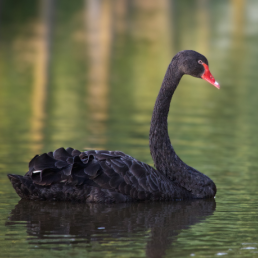

Join BirdNote tomorrow, November 30th!
Illustrator David Sibley and actor H. Jon Benjamin will face off in the bird illustration battle of the century during BirdNote's Year-end Celebration and Auction!
Humboldt Penguins living along the Pacific Coast of Chile and Peru are adapted to cold. But on land, temperatures rise to 100+ degrees, and penguins need to cool off. So these penguins have pink patches of bare skin on their face, under their wings, and on their feet. On hot days, the patches turn a deep, rosy color, as blood rushes to the surface to dissipate heat. They appear to be blushing, but they’re really flushing!
BirdNote®
Do Penguins Blush?
Written by Bob Sundstrom
This is BirdNote.
[Sound of ocean waves]
When most of us think of penguins, we picture snow and ice, right? But the Humboldt Penguin, that lives along the Pacific Coast of Chile and Peru, is well adapted to the extremes of both heat and cold.
[Humboldt Penguin sounds]
Humboldt Penguins are disappearing from the wild, and their taped sounds are incredibly rare. We made these recordings at the Woodland Park Zoo in Seattle.
[Humboldt Penguin sounds]
Like other penguins, they have dense layers of fat and feathers to insulate them against the cold seas.
But when on land, where temperatures can rise to over 100 degrees, the penguins need a way to cool down. Humboldt Penguins have pink patches of bare skin on their face, under their wings, and on their feet. These patches help keep them from over-heating.
[Humboldt Penguin sounds]
On a really hot day, the patches turn a deep, rosy color. The penguins look like they’re blushing! In those areas of bare skin, blood vessels dilate as extra blood rushes to the skin’s surface. More warm blood at the surface helps dissipate heat from the penguin’s body.
But scientists use the term “blushing” only when describing human reactions — like embarrassment.
So science tells us that a Humboldt Penguin’s face is flushing, not blushing.
[Humboldt Penguin sounds]
For BirdNote, I’m Mary McCann.
###
Bird sounds recorded by Jason Saul.
BirdNote’s theme music was composed and played by Nancy Rumbel and John Kessler.
Producer: John Kessler
Managing Producer: Jason Saul
Associate Producer: Ellen Blackstone
© 2017 Tune In to Nature.org September 2018/2019 / August 2022 Narrator: Mary McCann
ID# HUMPEN-01-2019-9-4 HUMPEN-01b
Humboldt Penguins: https://www.stlzoo.org/animals/abouttheanimals/birds/penguins/humboldtp…
Background: medically, blushing as a form of flushing - http://www.clevelandclinicmeded.com/medicalpubs/diseasemanagement/endoc…
Darwin quote: http://www.oxfordscholarship.com/view/10.1093/acprof:oso/9780198128298…
Blushing or Flushing? 426
Humboldt Penguins living along the Pacific Coast of Chile and Peru are adapted to cold. But on land, temperatures rise to 100+ degrees, and penguins need to cool off. So these penguins have pink patches of bare skin on their face, under their wings, and on their feet. On hot days, the patches turn a deep, rosy color, as blood rushes to the surface to dissipate heat. They appear to be blushing, but they’re really flushing! Learn more about biology, range, habitat and status of the Humboldt Penguin:
Quick facts on the Humboldt Penguin
http://www.arkive.org/humboldt-penguin/spheniscus- humboldti/
Guano farming and other threats to the bird
https://www.cpsg.org/blog/201912/planning-vulnerable-penguin-population…
How the Humboldt Penguin got its name
https://en.wikipedia.org/wiki/Humboldt_penguin
Learn more about Alexander Humboldt
https://www.eaglehill.us/humboldt-legacy.shtml



